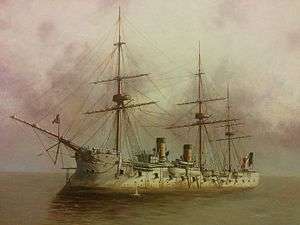French ship Duquesne (1876)
 Detail of "The Duquesne" (1903), painting of the twenty-one gun French ironclad cruiser, by Henry E. Traumer, on display at the Duquesne Club, Pittsburgh, Pennsylvania. | |
| History | |
|---|---|
| France | |
| Name: | Duquesne |
| Builder: | Arsenal de Rochefort |
| Laid down: | 1873 |
| Launched: | 1876 |
| Struck: | 1901 |
| General characteristics | |
| Class and type: | unprotected cruiser |
| Displacement: | 5,905 tonnes (5,812 long tons) |
| Length: | 100.4 meters at water level |
| Beam: | 15.2 meters |
| Draught: | 7.98 meters maximum |
| Speed: | 16.8 knots (31.1 km/h; 19.3 mph) |
| Range: | 4,400 nautical miles at 10 knots (8,149 km at 19 km/h) |
| Complement: | 551 |
The Duquesne was an ironclad unprotected cruiser built for the French navy. It was the sixth ship in the French navy to be named for Abraham Duquesne. It was laid down at Arsenal de Rochefort in 1873 and launched in 1876. It was in service for 25 years and was struck in 1901.
References
- Gogin, Ivan (2014). "Duquesne Iron Unprotected Cruiser (1878)". Navypedia. Retrieved 20 November 2016.
See also
This article is issued from Wikipedia - version of the 11/26/2016. The text is available under the Creative Commons Attribution/Share Alike but additional terms may apply for the media files.